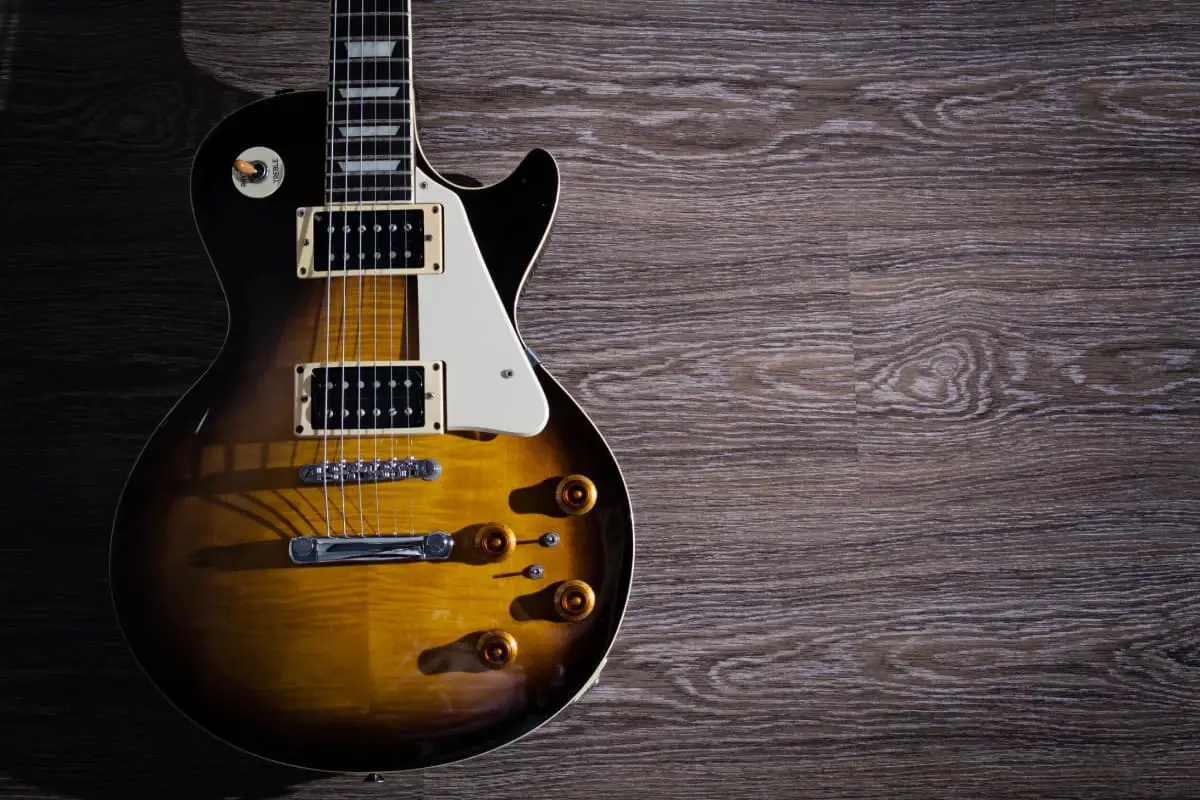Electric guitars are a notoriously weird bunch. Some have lightning bolt-shaped curves, some have horns and “fangs,” and others have whammy bars that can be used to dive bomb. Well, it’s safe to say that there’s no standard shape for an electric guitar–and the variety of shapes is part of why they are so cool.
Electric guitars are shaped the way they are for aesthetics, comfort, creative designs, and ease of use. Unlike acoustic guitars, the design has little importance to the sound of the final output, meaning that an electric guitar can be made of any shape.
Electric guitar shapes have been evolving and will continue to evolve into the future. In this article, we’ll take a closer look at why the different designs in the first place, how they affect your playing experience, and some of the features that make these designs possible.
👇😀👇NOTE👇😀👇
If you want to find out what my recommended guitar gear is, then here is what I recommend on Amazon:
- Fender Cutaway Acoustic-Electric Guitar Bundle (MY FAVORITE GUITAR)
- Snark SN-8 Super Tight All Instrument Tuner (Easiest Tuner I’ve Used😏)
- 6 String Acoustic Guitar Capo (Best CAPO for quick changes)
- Dunlop Max Grip 1.0mm Nylon Picks (Thick Guitar Pick So You Don’t Lose Grip!)
- Universal Guitar Stand (Cheap & Minimalist Guitar Stand I Recommend)
- Levy’s 2″ Wide Quick Adjust Guitar Strap (Best Guitar Strap For Any Level)
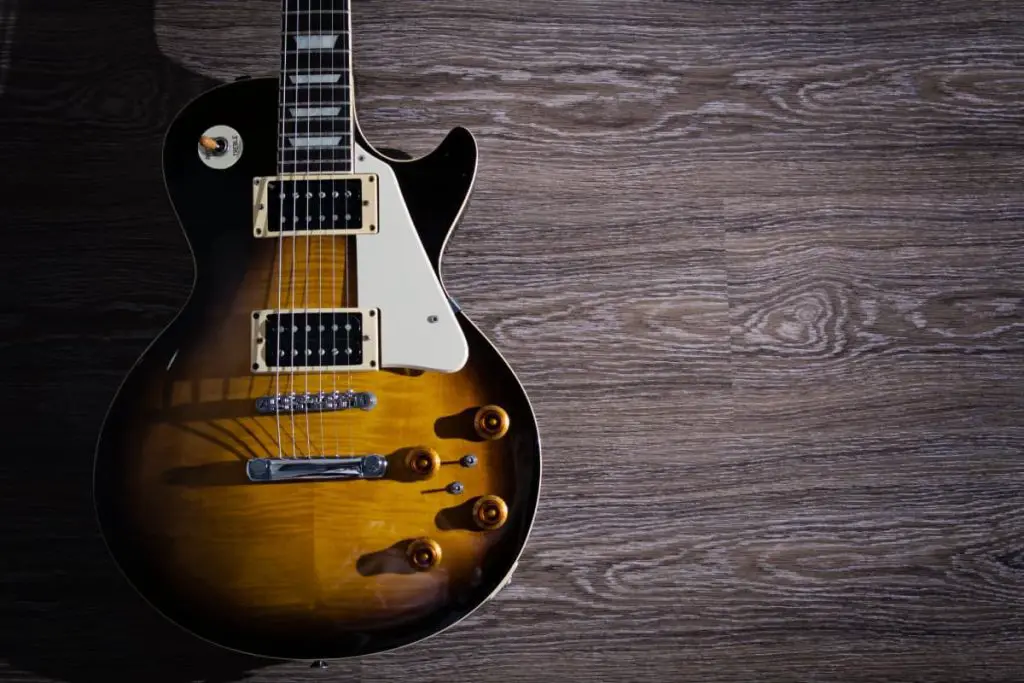
Electric Guitars Shapes vs. Acoustic Guitars
Electric guitars are often perceived as any type of guitar with a more slender form and a sharper appearance than the classic acoustic model. In fact, people tend to automatically assume that a slender body with pointed ends automatically belongs to an electric guitar. While this might be true on most occasions, it isn’t always the case; there are plenty of acoustic guitars out there with sleek bodies and little wood as well.
So, what are the differences between electric and acoustic guitars that bring out different shapes in both instruments? It all comes down to their construction and the materials used.
Let’s take a look at how these two instruments differ in terms of design, shapes, sound, and playing style:
- Thickness. Acoustic guitars tend to be much thicker than electric guitars, especially at the body end of the instrument. The added bracing gives the acoustic guitar a distinct tone and much of its volume during a performance. This means that they may be heavier as well. A large body can help dampen unwanted vibrations your picking hand produces when playing an acoustic guitar.
- Action height. The action on an electric guitar (the distance between the strings and the fretboard) can vary quite drastically between instruments depending on how much you play it (i.e., when you adjust it). However, it’s typically higher on an acoustic guitar.
- Body shape. Electric guitars tend to have a thinner body with a smaller overall size than traditional acoustics, with larger bodies and more wood responsible for their mellow, bass-focused tone. Body thickness in acoustic guitars is crucial in determining how the instrument will sound when amplified, so it’s not just for looks.
- Differences in the sound. The sound of an acoustic guitar is very different from the sound of an electric guitar. Acoustic guitars produce a warm, resonant sound rich in mid and low-end frequencies. On the other hand, electric guitars are known for their bright and crisp sound.
- Strings. The difference in sound is largely due to the type of strings each instrument uses. Acoustic guitars are fitted with strings made of either nylon or steel. On the other hand, electric guitars are fitted with strings made of either nickel-plated steel or pure nickel. Metal strings create electromagnetic disturbances in the pickups.
- Differences in construction. Acoustic guitars are typically made with a wooden soundboard fitted with a sound hole. Many types of wood are used in acoustic guitar construction, but the most common woods are spruce, cedar, and mahogany.
Electric guitars, on the other hand, are constructed a bit differently. Electric guitars are usually made with a solid wooden body, a wooden neck, and a wooden or sometimes metal fretboard. While there are some electric guitars that are made purely of metal, the use of wood in the construction of an electric guitar is much more prevalent.
The Anatomy of an Electric Guitar
Although guitars have differences in how they look and sound, they all share the same basic parts. Each guitar part outlined below has a functional purpose in sound production.
- The body. The guitar’s body is where most of the sound comes from. The type of wood making the body and its finish will affect the sound output.
- The bridge. The bridge is the point at which the strings are anchored to the guitar.
- The neck. The neck is the section of the guitar that connects the body and the headstock. The nut, frets, and truss rod are located on the neck of the guitar.
- The headstock. The headstock is the back end of the guitar where the tuning pegs are located. The tuning pegs can be adjusted to change the tension of the strings.
- The fretboard. The fretboard is the section of the guitar where the frets are mounted.
That’s the basic anatomy of any electric guitar on the market. As you can see, electric guitarists have a unique range of performance options compared to other guitarists.
The Evolution of the Electric Guitar Shapes
With the many designs on the market, you may wonder why all electric guitars share some resemblance with the very first guitars with little attempts to improve on the design. It may surprise you, but the first electric guitar was invented in 1932, after which a series of major modifications followed.
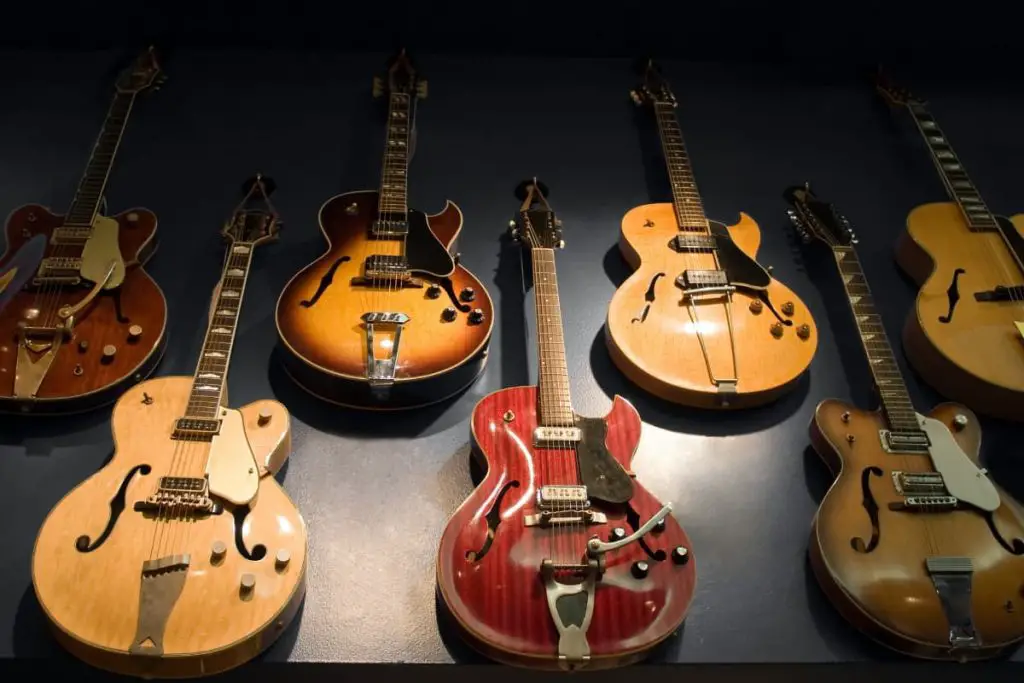
Here are the most important milestones in the development of the electric guitar:
- The Frying Pan. Rickenbacker Electro manufactured the first ever electric guitars designed by George Beauchamp in 1931. The design resembled a frying pan with a flat, circular body, hence its name.
- 1935: The Electro String (Bakelite Spanish Guitar). The body of the Electro String had a larger body than its predecessor, with a detachable neck.
- 1947: Bigsby Merle Travis Electric Guitar. Featured a single cutaway adjacent to the guitar’s neck and six tuners on one side of the headstock.
- 1954: Fender Stratocaster. Featured a double cutaway neck and three pickups, as opposed to the one or two pickups on most electric guitars at the time.
- 1982: Jackson Randy Rhoads. Unlike previous guitars with rounded cutaways adjacent to the fret, the Jackson Randy Rhoad featured a “shark fin” design.
Since then, other guitar designs have taken the industry by storm. And although the acceptance of the electric guitar was slow at the beginning, it had already become a widely-appreciated instrument by the 1960s. They would see future, more interesting developments.
Reasons Why Electric Guitars Are Shaped the Way They Are
Some electric guitars look entirely different from acoustic guitars. For starters, the body of an electric guitar is smaller and more streamlined because it doesn’t rely on resonance to amplify the strings. Electric guitars also have a different appearance partly because they are made of different materials, like solid wood and metal.
Here are more reasons why electric guitars are shaped the way they are:
Flexible Body Style Options
Acoustic guitars rely heavily on their hollow body to produce sound. When you pluck the strings, they vibrate in different tones, and the hollow body amplifies the sound for the audience. Unlike electric guitars, acoustic guitars don’t rely on electric pickups or other electronics to make their sound heard.
On the other hand, the electric guitar depends on magnetic pickups positioned below the strings to make its sound heard. This means that manufacturers can design their electric guitars as they like without being restricted by their shape – provided that the pickup is set in the right place.
With that in mind, here are some popular electric guitar body designs:
- Hollow-body electric guitars. As the name suggests, these guitars feature an internal cavity and a wooden outer layer. An example of a hollow body electric guitar is the Epiphone Casino.
- Semi-hollow electric guitars. Have a center block where the pickups are mounted. The Gibson ES-335 is a popular semi-hollow body guitar.
- Solid-body electric guitars. These guitars usually have a wood-only body, making them incredibly sturdy instruments. They are usually used for rock and heavy metal genres. They produce a clean, bright, and strong sound. Popular solid body guitars include the Fender Stratocaster and the Les Paul.
Aesthetics
In the early days of electric guitars, beauty was not a priority. Everything about these guitars was not designed with beauty in mind. The first models were made from cheap wood and metal with not-so-appealing paint jobs. However, over time, things changed for the better. Today’s electric guitars are much more aesthetically pleasing and as lovely to look at as they are to listen to.
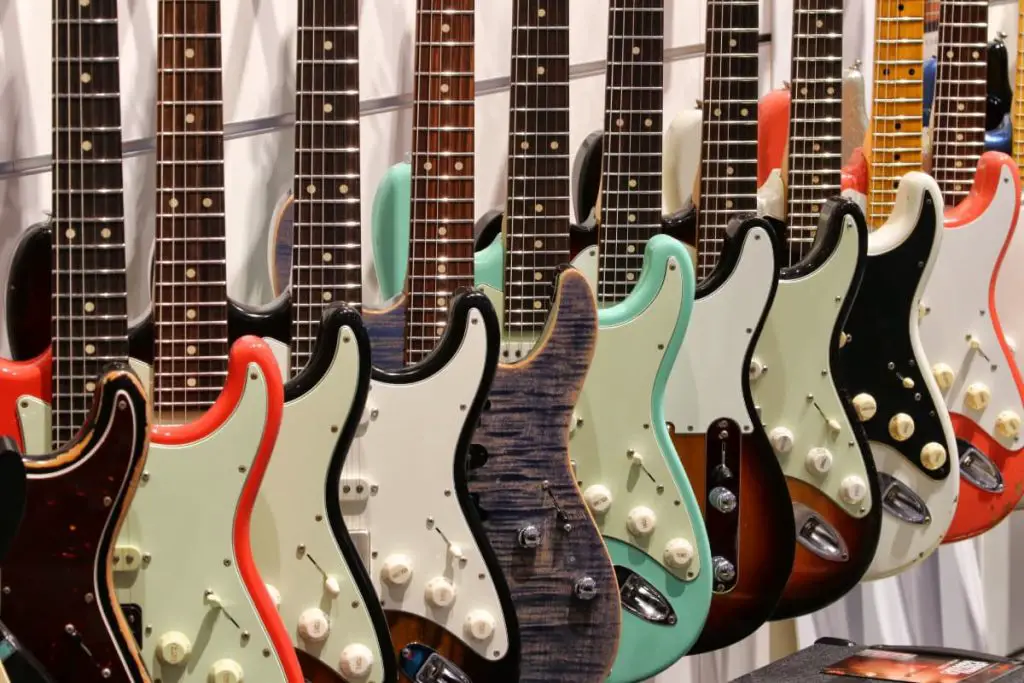
An electric guitar is a unique instrument, each with its own personality. Like acoustic guitars, there is a wide variety of shapes and sizes, from Stratocasters and Les Pauls to Telecasters and SGs. All these have their own appeal, and some are better suited for certain playing styles than others.
An electric guitar’s small, solid body packs a lot of potential for new, crazy designs that appeal to the modern audience. Since the shape doesn’t matter when it comes to sound production in an electric guitar, manufacturers have played around with various shapes and custom-made guitars for their customers without cutting back on the designs.
Electric Guitar Tradition
The electric guitar has long been the premiere instrument for rock and rollers, blues heroes, jazz maestros, and metal maniacs alike. It’s also one of the most visually striking instruments in the world, with even the most basic models featuring wild finishes, shapes, and colors.
There is a basic image that comes to mind whenever you think of an electric guitar. Another reason electric guitars are shaped the way they are is to keep the tradition. If you think about it, all electric guitars somehow trace back to the very first designs.
For Comfort
Electric guitar shapes and designs come in many, many different variations. From V-shaped double cutaways to more modest single cutaway versions, from pointy horns to flat and broad bodies–the variety of electric guitar bodies is almost endless.
Like many other guitars, the waist of the electric guitar is curved. This shape gives it the snuggly fit around your thigh if you prefer playing when seated. The shape also prevents the guitar from sliding down when playing and keeps it in place as your picking hand tries to reach out for the strings.
To Provide Easy Access to the Strings
As you may already know, the shape of any guitar has more to do with how easily you can play it. An electric guitar’s shape may impact your ease of accessing the fretboard. For example, guitars with double cutaways, such as the Stratocaster, allow you to easily access the higher notes that are otherwise difficult to access without the cutaways.
This is not to say that it’s impossible to play the guitar without cutaways. It may take some getting used to at first, but it would make a huge difference in how easily you can play your instrument.
Last but not least, your guitar’s shape affects your balance. The shape of a guitar is designed the way it is so that you can hold it properly in place when playing. This prevents the need to constantly have to readjust the position of your guitar.
Electric Guitar Shape Impact on Learning How To Play
Electric guitars are a great choice for beginners because they are easy to learn, but they do have one drawback: they don’t sound like acoustic guitars. If you’re used to playing an acoustic guitar, you’ll be disappointed when you try playing an electric guitar.
Their appearance can also affect learning; some models have more edges and pointed angles that might be challenging for a beginner. Electric guitars are smaller with thinner strings that are easier to play.
Does the Shape of an Electric Guitar Matter?
The shape of an electric guitar does matter as it has some impact on playability, which in turn affects the quality of your performance. Ultimately, the shape you choose comes down to personal preference and the genre you’re performing.
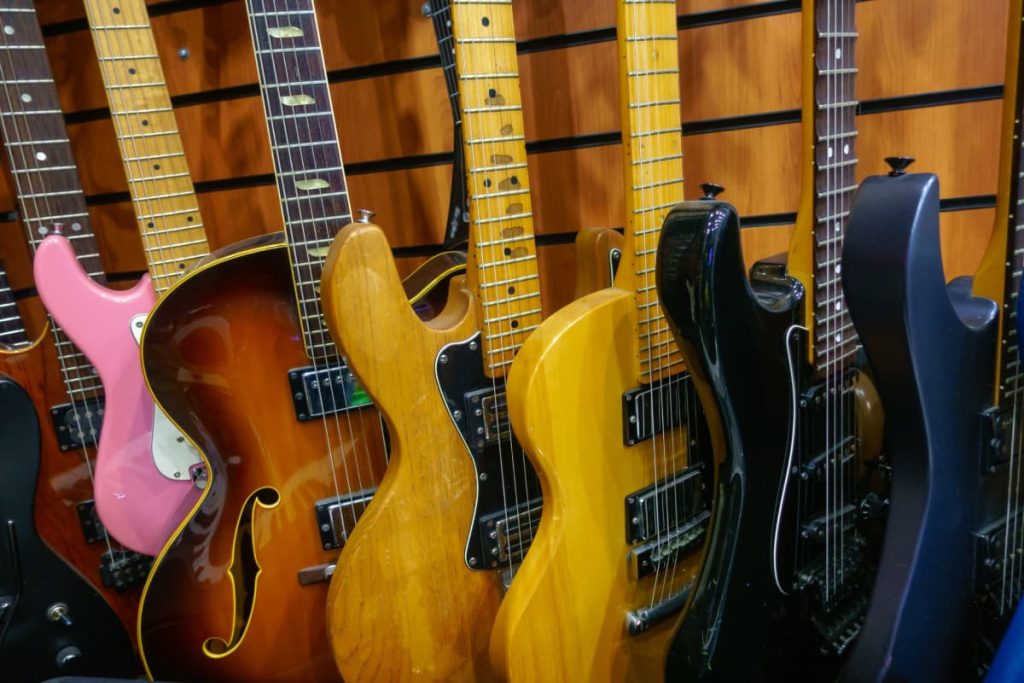
What does a guitar’s shape have to do with playing, you might ask?
When we talk about the shape of an electric guitar, we’re talking about the shape of the guitar from the headstock to the neck and body. The body is the part of the guitar where the strings are attached and all the other major components are placed.
The headstock is the part at the top of the body where the tuners are located. The strings are guided downward before being tightened and secured in place by the bridge. The player needs to access the fret and each string without hassle. If the shape of the guitar limits quick access to the strings and controls, the player may find it hard to play the guitar, especially if they’re new to it.
Some shapes are better suited to certain playing styles and genres than others. For example, an SG-style electric guitar is great for hard rock and metal, but it might not be the best choice for country or folk. Ultimately, the best electric guitar for you is the one that fits your playing style.
Does the Shape of an Electric Guitar Affect Sound?
It doesn’t take much effort to see that the electric guitar is quite simple in design. As long as the neck, body, and bridge are properly constructed and the strings are tuned correctly, you should be able to play just about any type of song and get some decent chords.
The shape of an electric guitar does not affect the sound. While playing an asymmetrical guitar can be slightly more challenging, the only real differences are aesthetic. The materials and construction of the body will have a much larger impact on the final sound than the shape of the guitar itself.
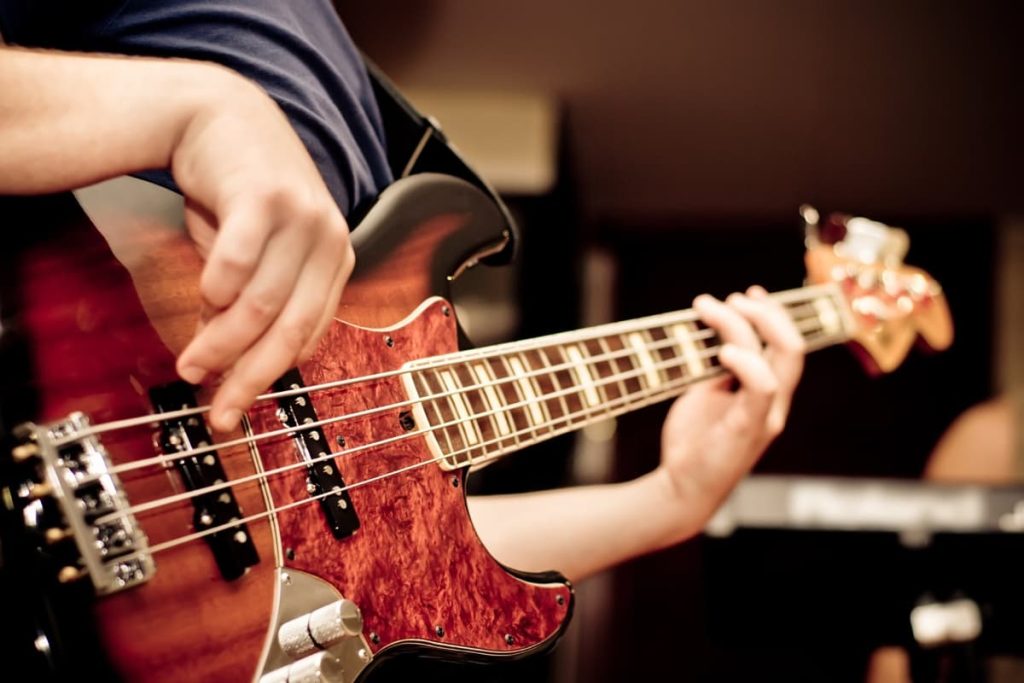
So, if the shape doesn’t affect the sound of an electric guitar, what does?
- Pickups. The pickup is what converts the vibrations from your strings into an electrical signal, which it then sends to an amplifier. Pickups can be divided into single-coil and humbuckers (also known as double-coil pickups). Single-coil pickups produce a brighter tone, while humbuckers produce a louder and warmer sound.
- Pickup position. How your pickups are positioned makes quite a difference in how they respond to the strings. They pick up weak sound signals if they’re placed too far away from the strings.
- Body wood type. Different types of wood are used to make different kinds of guitars, which can impact the sound you get from your instrument. Alder produces a clear, balanced tone. Ash has more midrange, basswood is warm and punchy, and spruce gives off an acoustic-like quality with lots of bass.
- Strings. Strings have an impact on your guitar’s tone as well as its playability, durability, and tuning stability. The material that strings are made from affects their sound. Steel strings are common in electric guitars for their brighter tone.
Conclusion
At first glance, an electric guitar seems like a fairly simple instrument– it’s just a wooden shape with six strings. However, electric guitars come in all complicated shapes, sizes, colors, and styles, from vintage reissues to modern superstrats. Whether you’re a beginner or professional, there’s something out there for you.
👇😀👇NOTE👇😀👇
If you want to find out what my recommended guitar gear is, then here is what I recommend on Amazon:
- Fender Cutaway Acoustic-Electric Guitar Bundle (MY FAVORITE GUITAR)
- Snark SN-8 Super Tight All Instrument Tuner (Easiest Tuner I’ve Used😏)
- 6 String Acoustic Guitar Capo (Best CAPO for quick changes)
- Dunlop Max Grip 1.0mm Nylon Picks (Thick Guitar Pick So You Don’t Lose Grip!)
- Universal Guitar Stand (Cheap & Minimalist Guitar Stand I Recommend)
- Levy’s 2″ Wide Quick Adjust Guitar Strap (Best Guitar Strap For Any Level)
Related Posts:
- 10 Best Lightest Electric Guitars that Play & Sound Great!
- 5 Reasons Why All Electric Guitars Sound Different
- How To Clean Dust Off an Electric Guitar (8 Easy Steps)
- How To Test an Electric Guitar Without an Amp
- How To Make Any Electric Guitar Sound Like a Bass
- Electric Guitar vs. Acoustic Amp: Differences Explained
- How To Clean an Electric Guitar Bridge: 7 Steps
- 7 Reasons Why Electric Guitars Cost So Much
- Best Electric Guitars

